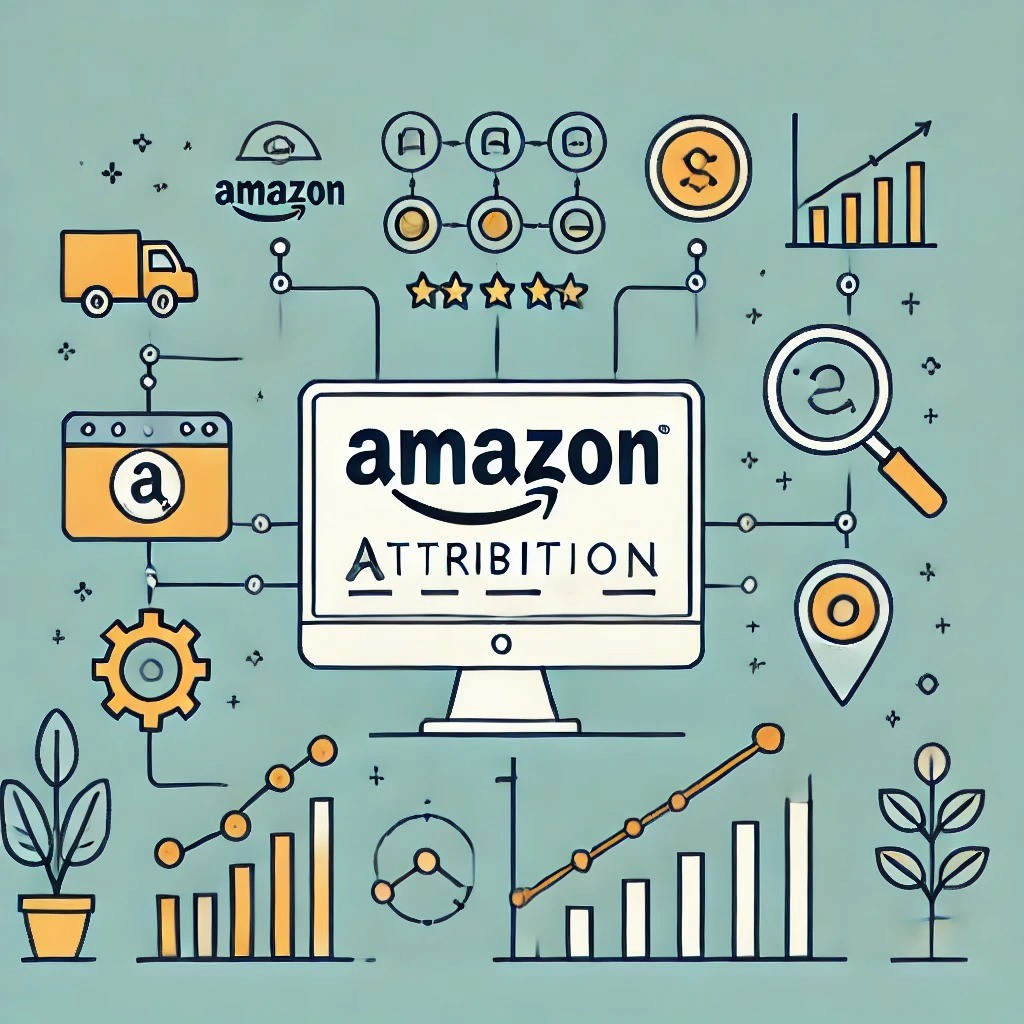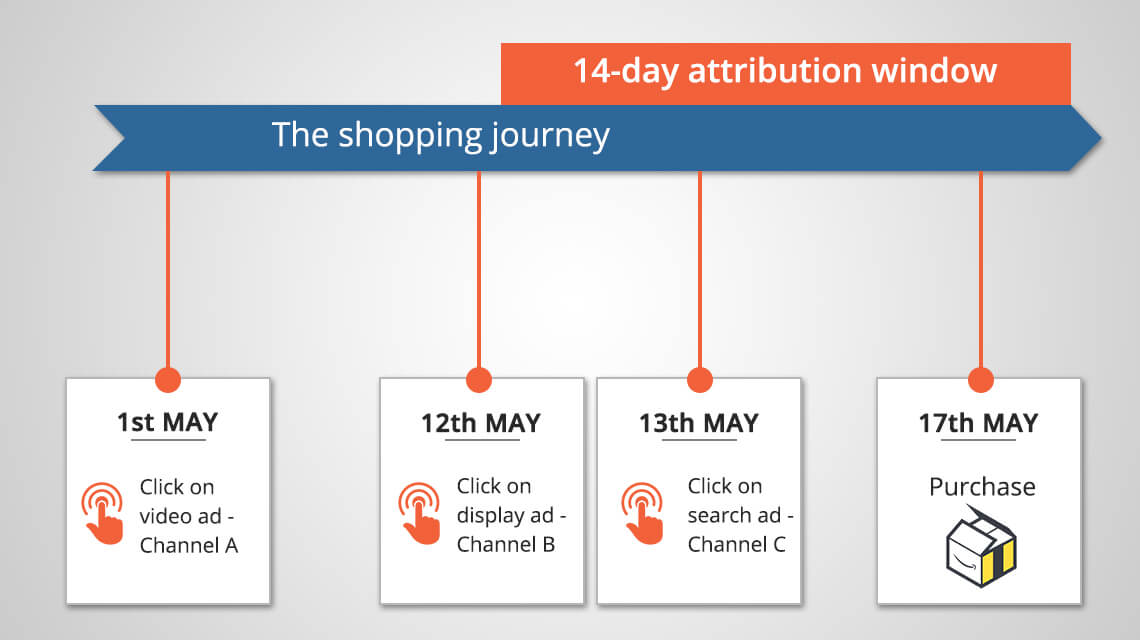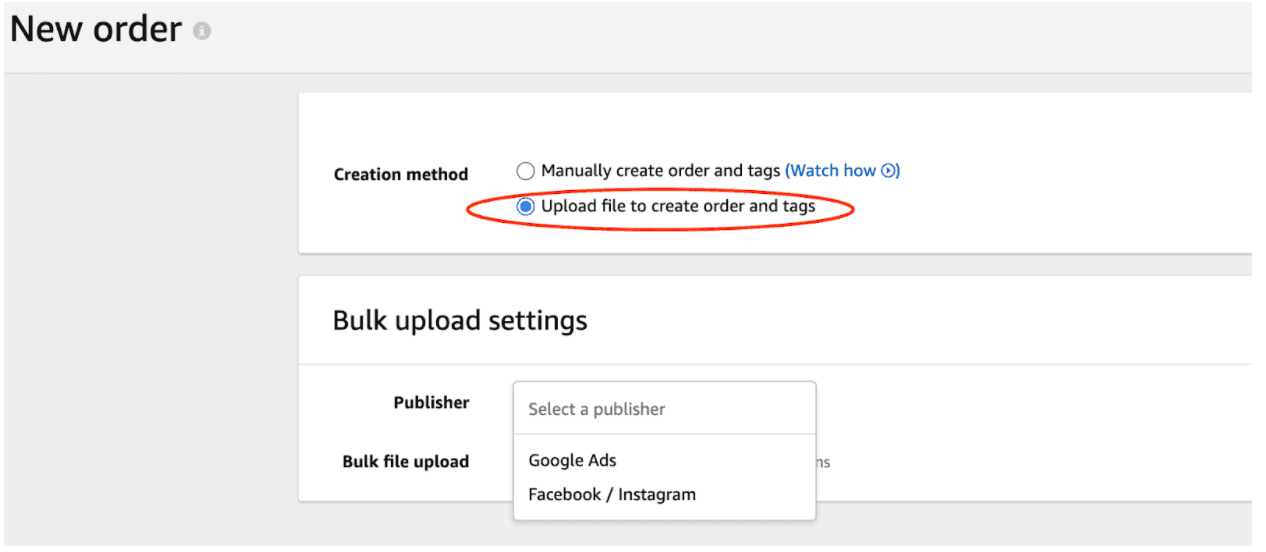Back to Page
Amazon Attribution
What is Amazon Attribution & How To Get Started? (2021 Updates)
What is Amazon Attribution & How To Get Started? (2021 Updates)


Back to Page
Amazon Attribution
What is Amazon Attribution & How To Get Started? (2021 Updates)

Last month, Amazon announced the launch of Brand Referral Bonus, a program that lets brands monetize their off Amazon marketing efforts. On average, registered brand owners selling in the USA can earn a 10% bonus from qualifying for Amazon sales. With the launch of this program, Amazon sellers now have another reason to expand their reach and experiment with ads on platforms like Google, Facebook, Instagram, etc. But before you start bumping your off-Amazon marketing efforts, be sure to register for the Amazon Attribution program if you haven’t already. Any sales that do not come through an attribution tag won’t be credited toward your eventual bonus. In this blog post, let’s take a closer look at Amazon Attribution, what is an Attribution tag is, how Amazon Attribution works, and how you can use it to improve your campaign performance.
What is Amazon Attribution?

Amazon Attribution is a free solution designed to help brands measure the performance of their search, display, video, social media, and email-based campaigns. The crucial off-Amazon-to-Amazon marketing insights let brands better optimize their campaigns and improve their ROI.
Amazon Attribution allows brands to:
Measure: Know which advertising channel is the most effective at driving sales.
Optimize: Metrics like conversion rates, clickthrough rates, etc., help optimize campaigns to improve performance.
Plan: Review performance and develop a plan of action for future ad campaigns.
Why was this program launched?
Every Amazon seller who drives external traffic to their listing knows the struggle of analyzing campaign performance. Until last year, they were left out in the dark to guess whether the customer eventually purchased the product or not, how their campaigns were performing, and whether there was room for improvement. If you sold 500 units, you know 250 were from PPC, but what about the other 250? Were these organic sales, sales generated from off-Amazon efforts, or did buyers just happen to stumble across the listing? There was no way to find out. Amazon Attribution changes this by giving brands the data needed to optimize their off-Amazon marketing efforts. Brands can now create full-funnel, multi-channel campaigns that support their goals and grow product sales.
Who can use it?
Amazon Attribution is available for brand-registered sellers and vendors. Currently, it is available in the following marketplaces:
North America: US & CA
Europe: DE, ES, FR, IT, UK
This program is in Beta and will open up to other marketplaces in the future.
Amazon Attribution provides insights into the following KPIs:
Click-throughs
Impressions
Detail page views
Purchase rate
Add to cart
Total Sales
Brands can know which platform is driving more sales and which are losing money. They can also know exactly where their customers are dropping out of the funnel. The KPIs help improve the performance of campaigns. For example, if your clickthrough rates are high but you do not see the sales, it means there are issues in your listing copy, price, images, stock availability, or Buy Box.
Understanding the metrics

It is crucial to understand where each of the metrics fits into the sales and marketing funnel. Understanding and analyzing these metrics helps brands optimize their campaigns to meet their specific goals.
If you want to increase awareness, focus on clicks.
If you want to maximize purchase intent by telling your brand and product story, focus on detailed page views and add to carts.
If you want to increase sales, focus on purchase & sales.
If you want to re-engage your current customers and drive additional purchases, focus on all of the above.
The methodology

Amazon Attribution utilizes a 14-day lookback window. As shown in the example above, the click-on video ad on May 1st won’t be credited for sales since it is outside the 14-day window. The last click will receive credit for the conversion. In this case, the click on May 13th receives the credit for the sales on May 17th.
What is an Attribution Tag?
It is a tracking URL you create under your Amazon Attribution account. Brands should generate a URL and put it in their ads, blog articles, emails, or any other medium from which they want to drive traffic. The tag sticks to the customer’s entire journey till they reach your Amazon detail page, where they may or may not buy. Whenever a shopper clicks on the URL, Amazon will track and give brands useful insights into the action they took.
How to create an Attribution Tag?
Before creating a tag, you need to log in to your Seller Central account and set up your account in Amazon Attribution.
Creating tags is quite simple:
Select the advertiser name you need to create a tag for

Image ref: Jungle Scout
Hit the “New Order” button.

For Google Ads, select “Upload a file” and follow the instructions. For everywhere else, click on “Manually create order & tags.”

Choose the product you want to advertise and “Add” it.
In the order section, give a name and ID to the tag and “Continue to line items.”
Choose where you want to post the link from the publisher drop-down menu.
In Click-through URL, give your listing a URL and hit the “Create” button.
Congratulations, you’ve created your Amazon Attribution tag.
Best practices for Amazon Attribution
#1: Set up a campaign goal

Do you want to boost brand awareness, increase consideration of your products, or drive sales to get an edge over your competitors? Identifying your goal will help you craft an effective action plan and enable you to quickly understand what’s working and what’s not.
#2: Optimize the best performing channels

Which duds are losing you money, and which channels are bringing in more sales? Optimize channels that generate the most profits and leverage that data to improve the performance of low-performing channels.
#3: Target the right audience

Your audience acts differently on different platforms. Leveraging the data, identify which non-Amazon audiences are most valuable to your business and which require different engagement strategies. #4: Ensure your creatives are in line with your brand Your ad messaging, ad creatives, colors, fonts, etc., should resonate with your brand on every platform. This way, customers will be able to easily identify your brand and be willing to interact with it.
#5: A/B test landing page on Amazon

The metrics are also based on where you direct your customers – Amazon seller storefront or detail pages. Test different landing pages based on where shoppers are on their journeys, where they’re coming from, or what they can do next.
#6: Optimize your landing pages
Be it your detail page or your storefront, it is necessary that they are retail-ready for the traffic. Before you kick-start your Amazon Attribution campaign, hire Amazon Listing Optimization services to make sure your listing and storefront are built for conversion.
#7: Do not DIY

Although Amazon advertises Amazon Attribution as a self-service tool, it is not. Managing and optimizing campaigns is much more complex than it sounds. Let eStore Factory’s Amazon PPC optimization experts handle your Attribution campaigns while you can just sit back and watch the profits roll in.
Amazon wants you to level your Amazon marketing efforts
The launch of Amazon Attribution in 2020 and the Brand Referral Bonus program in 2021 have proved that Amazon wants brands to ramp up their external traffic efforts. If you have been on the fence about investing in off-Amazon advertising campaigns, now is the time to unleash your inner marketer and make some extra dough. If you are ready to jump on the off-Amazon marketing bandwagon, we can help you set up, optimize, manage, and scale your campaigns. Right from designing creatives for your campaign to tweaking bids and optimizing results, our Amazon consultants can help you with everything.
Related blog post: Brand Referral Bonus: Monetize Your Off-Amazon Marketing Efforts
Last month, Amazon announced the launch of Brand Referral Bonus, a program that lets brands monetize their off Amazon marketing efforts. On average, registered brand owners selling in the USA can earn a 10% bonus from qualifying for Amazon sales. With the launch of this program, Amazon sellers now have another reason to expand their reach and experiment with ads on platforms like Google, Facebook, Instagram, etc. But before you start bumping your off-Amazon marketing efforts, be sure to register for the Amazon Attribution program if you haven’t already. Any sales that do not come through an attribution tag won’t be credited toward your eventual bonus. In this blog post, let’s take a closer look at Amazon Attribution, what is an Attribution tag is, how Amazon Attribution works, and how you can use it to improve your campaign performance.
What is Amazon Attribution?

Amazon Attribution is a free solution designed to help brands measure the performance of their search, display, video, social media, and email-based campaigns. The crucial off-Amazon-to-Amazon marketing insights let brands better optimize their campaigns and improve their ROI.
Amazon Attribution allows brands to:
Measure: Know which advertising channel is the most effective at driving sales.
Optimize: Metrics like conversion rates, clickthrough rates, etc., help optimize campaigns to improve performance.
Plan: Review performance and develop a plan of action for future ad campaigns.
Why was this program launched?
Every Amazon seller who drives external traffic to their listing knows the struggle of analyzing campaign performance. Until last year, they were left out in the dark to guess whether the customer eventually purchased the product or not, how their campaigns were performing, and whether there was room for improvement. If you sold 500 units, you know 250 were from PPC, but what about the other 250? Were these organic sales, sales generated from off-Amazon efforts, or did buyers just happen to stumble across the listing? There was no way to find out. Amazon Attribution changes this by giving brands the data needed to optimize their off-Amazon marketing efforts. Brands can now create full-funnel, multi-channel campaigns that support their goals and grow product sales.
Who can use it?
Amazon Attribution is available for brand-registered sellers and vendors. Currently, it is available in the following marketplaces:
North America: US & CA
Europe: DE, ES, FR, IT, UK
This program is in Beta and will open up to other marketplaces in the future.
Amazon Attribution provides insights into the following KPIs:
Click-throughs
Impressions
Detail page views
Purchase rate
Add to cart
Total Sales
Brands can know which platform is driving more sales and which are losing money. They can also know exactly where their customers are dropping out of the funnel. The KPIs help improve the performance of campaigns. For example, if your clickthrough rates are high but you do not see the sales, it means there are issues in your listing copy, price, images, stock availability, or Buy Box.
Understanding the metrics

It is crucial to understand where each of the metrics fits into the sales and marketing funnel. Understanding and analyzing these metrics helps brands optimize their campaigns to meet their specific goals.
If you want to increase awareness, focus on clicks.
If you want to maximize purchase intent by telling your brand and product story, focus on detailed page views and add to carts.
If you want to increase sales, focus on purchase & sales.
If you want to re-engage your current customers and drive additional purchases, focus on all of the above.
The methodology

Amazon Attribution utilizes a 14-day lookback window. As shown in the example above, the click-on video ad on May 1st won’t be credited for sales since it is outside the 14-day window. The last click will receive credit for the conversion. In this case, the click on May 13th receives the credit for the sales on May 17th.
What is an Attribution Tag?
It is a tracking URL you create under your Amazon Attribution account. Brands should generate a URL and put it in their ads, blog articles, emails, or any other medium from which they want to drive traffic. The tag sticks to the customer’s entire journey till they reach your Amazon detail page, where they may or may not buy. Whenever a shopper clicks on the URL, Amazon will track and give brands useful insights into the action they took.
How to create an Attribution Tag?
Before creating a tag, you need to log in to your Seller Central account and set up your account in Amazon Attribution.
Creating tags is quite simple:
Select the advertiser name you need to create a tag for

Image ref: Jungle Scout
Hit the “New Order” button.

For Google Ads, select “Upload a file” and follow the instructions. For everywhere else, click on “Manually create order & tags.”

Choose the product you want to advertise and “Add” it.
In the order section, give a name and ID to the tag and “Continue to line items.”
Choose where you want to post the link from the publisher drop-down menu.
In Click-through URL, give your listing a URL and hit the “Create” button.
Congratulations, you’ve created your Amazon Attribution tag.
Best practices for Amazon Attribution
#1: Set up a campaign goal

Do you want to boost brand awareness, increase consideration of your products, or drive sales to get an edge over your competitors? Identifying your goal will help you craft an effective action plan and enable you to quickly understand what’s working and what’s not.
#2: Optimize the best performing channels

Which duds are losing you money, and which channels are bringing in more sales? Optimize channels that generate the most profits and leverage that data to improve the performance of low-performing channels.
#3: Target the right audience

Your audience acts differently on different platforms. Leveraging the data, identify which non-Amazon audiences are most valuable to your business and which require different engagement strategies. #4: Ensure your creatives are in line with your brand Your ad messaging, ad creatives, colors, fonts, etc., should resonate with your brand on every platform. This way, customers will be able to easily identify your brand and be willing to interact with it.
#5: A/B test landing page on Amazon

The metrics are also based on where you direct your customers – Amazon seller storefront or detail pages. Test different landing pages based on where shoppers are on their journeys, where they’re coming from, or what they can do next.
#6: Optimize your landing pages
Be it your detail page or your storefront, it is necessary that they are retail-ready for the traffic. Before you kick-start your Amazon Attribution campaign, hire Amazon Listing Optimization services to make sure your listing and storefront are built for conversion.
#7: Do not DIY

Although Amazon advertises Amazon Attribution as a self-service tool, it is not. Managing and optimizing campaigns is much more complex than it sounds. Let eStore Factory’s Amazon PPC optimization experts handle your Attribution campaigns while you can just sit back and watch the profits roll in.
Amazon wants you to level your Amazon marketing efforts
The launch of Amazon Attribution in 2020 and the Brand Referral Bonus program in 2021 have proved that Amazon wants brands to ramp up their external traffic efforts. If you have been on the fence about investing in off-Amazon advertising campaigns, now is the time to unleash your inner marketer and make some extra dough. If you are ready to jump on the off-Amazon marketing bandwagon, we can help you set up, optimize, manage, and scale your campaigns. Right from designing creatives for your campaign to tweaking bids and optimizing results, our Amazon consultants can help you with everything.
Related blog post: Brand Referral Bonus: Monetize Your Off-Amazon Marketing Efforts
Last month, Amazon announced the launch of Brand Referral Bonus, a program that lets brands monetize their off Amazon marketing efforts. On average, registered brand owners selling in the USA can earn a 10% bonus from qualifying for Amazon sales. With the launch of this program, Amazon sellers now have another reason to expand their reach and experiment with ads on platforms like Google, Facebook, Instagram, etc. But before you start bumping your off-Amazon marketing efforts, be sure to register for the Amazon Attribution program if you haven’t already. Any sales that do not come through an attribution tag won’t be credited toward your eventual bonus. In this blog post, let’s take a closer look at Amazon Attribution, what is an Attribution tag is, how Amazon Attribution works, and how you can use it to improve your campaign performance.
What is Amazon Attribution?

Amazon Attribution is a free solution designed to help brands measure the performance of their search, display, video, social media, and email-based campaigns. The crucial off-Amazon-to-Amazon marketing insights let brands better optimize their campaigns and improve their ROI.
Amazon Attribution allows brands to:
Measure: Know which advertising channel is the most effective at driving sales.
Optimize: Metrics like conversion rates, clickthrough rates, etc., help optimize campaigns to improve performance.
Plan: Review performance and develop a plan of action for future ad campaigns.
Why was this program launched?
Every Amazon seller who drives external traffic to their listing knows the struggle of analyzing campaign performance. Until last year, they were left out in the dark to guess whether the customer eventually purchased the product or not, how their campaigns were performing, and whether there was room for improvement. If you sold 500 units, you know 250 were from PPC, but what about the other 250? Were these organic sales, sales generated from off-Amazon efforts, or did buyers just happen to stumble across the listing? There was no way to find out. Amazon Attribution changes this by giving brands the data needed to optimize their off-Amazon marketing efforts. Brands can now create full-funnel, multi-channel campaigns that support their goals and grow product sales.
Who can use it?
Amazon Attribution is available for brand-registered sellers and vendors. Currently, it is available in the following marketplaces:
North America: US & CA
Europe: DE, ES, FR, IT, UK
This program is in Beta and will open up to other marketplaces in the future.
Amazon Attribution provides insights into the following KPIs:
Click-throughs
Impressions
Detail page views
Purchase rate
Add to cart
Total Sales
Brands can know which platform is driving more sales and which are losing money. They can also know exactly where their customers are dropping out of the funnel. The KPIs help improve the performance of campaigns. For example, if your clickthrough rates are high but you do not see the sales, it means there are issues in your listing copy, price, images, stock availability, or Buy Box.
Understanding the metrics

It is crucial to understand where each of the metrics fits into the sales and marketing funnel. Understanding and analyzing these metrics helps brands optimize their campaigns to meet their specific goals.
If you want to increase awareness, focus on clicks.
If you want to maximize purchase intent by telling your brand and product story, focus on detailed page views and add to carts.
If you want to increase sales, focus on purchase & sales.
If you want to re-engage your current customers and drive additional purchases, focus on all of the above.
The methodology

Amazon Attribution utilizes a 14-day lookback window. As shown in the example above, the click-on video ad on May 1st won’t be credited for sales since it is outside the 14-day window. The last click will receive credit for the conversion. In this case, the click on May 13th receives the credit for the sales on May 17th.
What is an Attribution Tag?
It is a tracking URL you create under your Amazon Attribution account. Brands should generate a URL and put it in their ads, blog articles, emails, or any other medium from which they want to drive traffic. The tag sticks to the customer’s entire journey till they reach your Amazon detail page, where they may or may not buy. Whenever a shopper clicks on the URL, Amazon will track and give brands useful insights into the action they took.
How to create an Attribution Tag?
Before creating a tag, you need to log in to your Seller Central account and set up your account in Amazon Attribution.
Creating tags is quite simple:
Select the advertiser name you need to create a tag for

Image ref: Jungle Scout
Hit the “New Order” button.

For Google Ads, select “Upload a file” and follow the instructions. For everywhere else, click on “Manually create order & tags.”

Choose the product you want to advertise and “Add” it.
In the order section, give a name and ID to the tag and “Continue to line items.”
Choose where you want to post the link from the publisher drop-down menu.
In Click-through URL, give your listing a URL and hit the “Create” button.
Congratulations, you’ve created your Amazon Attribution tag.
Best practices for Amazon Attribution
#1: Set up a campaign goal

Do you want to boost brand awareness, increase consideration of your products, or drive sales to get an edge over your competitors? Identifying your goal will help you craft an effective action plan and enable you to quickly understand what’s working and what’s not.
#2: Optimize the best performing channels

Which duds are losing you money, and which channels are bringing in more sales? Optimize channels that generate the most profits and leverage that data to improve the performance of low-performing channels.
#3: Target the right audience

Your audience acts differently on different platforms. Leveraging the data, identify which non-Amazon audiences are most valuable to your business and which require different engagement strategies. #4: Ensure your creatives are in line with your brand Your ad messaging, ad creatives, colors, fonts, etc., should resonate with your brand on every platform. This way, customers will be able to easily identify your brand and be willing to interact with it.
#5: A/B test landing page on Amazon

The metrics are also based on where you direct your customers – Amazon seller storefront or detail pages. Test different landing pages based on where shoppers are on their journeys, where they’re coming from, or what they can do next.
#6: Optimize your landing pages
Be it your detail page or your storefront, it is necessary that they are retail-ready for the traffic. Before you kick-start your Amazon Attribution campaign, hire Amazon Listing Optimization services to make sure your listing and storefront are built for conversion.
#7: Do not DIY

Although Amazon advertises Amazon Attribution as a self-service tool, it is not. Managing and optimizing campaigns is much more complex than it sounds. Let eStore Factory’s Amazon PPC optimization experts handle your Attribution campaigns while you can just sit back and watch the profits roll in.
Amazon wants you to level your Amazon marketing efforts
The launch of Amazon Attribution in 2020 and the Brand Referral Bonus program in 2021 have proved that Amazon wants brands to ramp up their external traffic efforts. If you have been on the fence about investing in off-Amazon advertising campaigns, now is the time to unleash your inner marketer and make some extra dough. If you are ready to jump on the off-Amazon marketing bandwagon, we can help you set up, optimize, manage, and scale your campaigns. Right from designing creatives for your campaign to tweaking bids and optimizing results, our Amazon consultants can help you with everything.
Related blog post: Brand Referral Bonus: Monetize Your Off-Amazon Marketing Efforts






